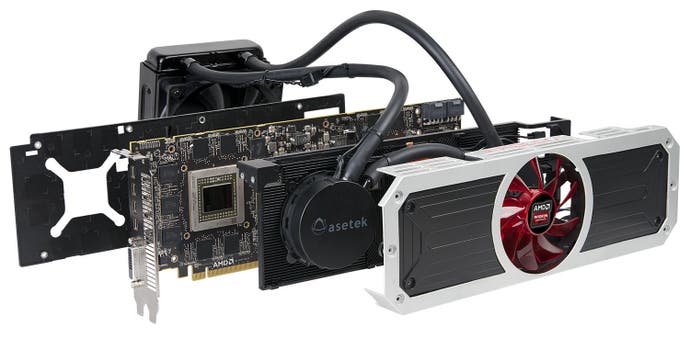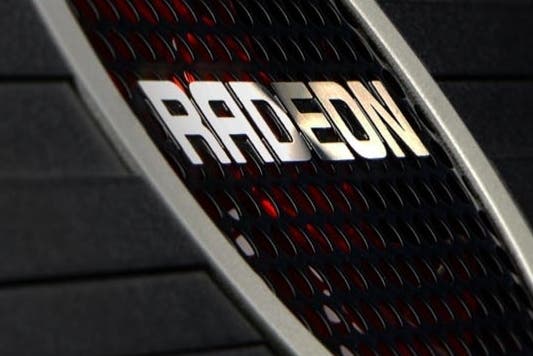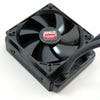AMD Radeon R9 295X2 review
11.5 teraflops of rendering power - Digital Foundry stress-tests the world's fastest graphics card.
11.5 teraflops in a single GPU - now that's power. Hot on the heels of the reveal of Nvidia's mammoth $3000 Titan-Z, AMD has completed work on its own halo product - the Radeon R9 295X2. It has much in common with its competitor: it brings together two top-of-the-line GPUs into one graphics card, effectively cramming two R9 290Xs into a single product. AMD says that this card is meant for the ultra high-end enthusiast - those who crave top-end performance at 4K resolution.
But it's in the differences with Titan-Z where we see the 295X2 come into its own. Cost-wise, there's no competition. At $1500, it's half the price of Nvidia's upcoming offering. It also comes with the first hybrid air/liquid cooling solution found in a reference graphics card - and it needs it. AMD's Hawaii chip is one of the most powerful GPUs on the market, but it also consumes a large amount of power, and produces excessive amounts of heat. It's rated to operate at 95 degrees Celsius, and in the 290 and 290X, it will sit at that high temperature under load, often throttling performance in the sub-optimal reference design. Two of these things in a single card sounds like a recipe for disaster, but the extreme cooling solution utilised in the 295X2 is remarkable: mounted in a case and subject to heavy load, temperatures barely hit the 70 degrees Celsius barrier. In fact, the cooling is so good that AMD even bumped up the card's clock speed a tad over the standard single-chip R9 290X and lowered max operating temperature by a full 20 degrees, down to 75 Celsius.
Taking a look at the card itself reveals how this was done. In addition to the standard heatsink and fan, the 295X2 includes a closed-loop water-cooling system provided by specialist Asetek. Twin pipes emerge from the shroud, linking up to a radiator arrangement that you attach to a 120mm fan placement on your chassis. Gone are the days of simply slotting in the GPU and attaching some power cables - this requires a touch more effort. However, the end result is a cool GPU and a card that's actually quieter than the R9 290X in its performance-sapping 'quiet' mode. In our case, the power supply fan was actually louder - perhaps not surprising, bearing in mind that AMD recommends a 1000W PSU.
In terms of build quality, this is an enormous departure from AMD's recent, somewhat lacking reference designs - it features an anodised aluminium shroud, quality heatsink and decent fan, and even the back of the board itself is hard, durable metal. Red LEDs highlight the cooling and the Radeon branding. This may not quite match the aesthetics of Nvidia's top-end products, but it looks the part and the cooling performance speaks for itself.
Connections are impressive, if minimalist. There's a single dual-link DVI socket and four mini DisplayPorts. There's a lack of HDMI here, but given AMD's contention that this is not meant for 1080p/1440p/1600p gamers, that's perhaps understandable - though we don't agree with the premise. Regardless, the ability to drive five different displays from a single card will probably be useful, especially given AMD's focus on its EyeFinity multi-monitor technology.
We went into testing the R9 295X2 with some level of scepticism. After the frame-pacing issues were fully revealed, AMD lost a lot of confidence with the high-end enthusiast - and with good reason. Despite posting stunning benchmarks, frame analysis revealed that AMD's CrossFire tech had fundamental issues - a good proportion of frames that were processed by the GPU were either displayed for a split second or never displayed at all. An initial driver fix was supposed to address the issue, but in our Radeon HD 7990 review we still found unsatisfactory performance - in essence, there were moments where the 7990 would act just like a single-GPU card, nullifying the whole point of the product - in our testing this wasn't so much micro-stutter as macro-stutter. The 7990 annihilated GTX Titan in terms of raw benchmarks, but the single GPU simply produced more consistent, reliable performance, quickly becoming the enthusiast's choice until the GTX 780 and GTX 780 Ti arrived.
Going into this 295X2 review, then, we had a number of objectives, principal among them discovering to what extent this card can run high-end games at 4K resolution as close to 60fps as possible. On top of that, while AMD is consciously pushing us away from using the 295X2 for lower resolutions, we wanted to see just how powerful the card was at 1080p and 2.5K. Next, we wanted to re-evaluate CrossFire to see whether AMD's attempts to fix the frame-pacing problems have actually worked this time - and by extension, whether a dual GPU product operates as it should. And finally, we wanted to put the whole focus of the "halo product" into perspective. Does the inflated price point actually make sense here? Or would you be better off buying two GPUs and saving a ton of money into the bargain?
First up, we benchmarked the new cards across the three major high-end resolutions: 1920x1080 (1080p), 2560x1440 (1440p) and finally, full 4K - 3840x2160. AMD suggests that the higher the resolution, the more effective the GPU becomes. 4K is effectively four times the resolution of 1080p, but the argument is that you won't see a 4x hit to frame-rates. Certainly, the wide 512-bit memory buses attached to both of the Hawaii GPUs coupled with the large 4GB of GDDR5 available to each core should ensure that the video memory is there, along with a wide enough pipe to keep the shaders serviced. Here are our results - based on presets ramped up to the max. We use FCAT analysis for all GPU benchmarks. This effectively uses video captures to properly ascertain performance, ensuring that what you see on-screen is what is being analysed.
"What quickly becomes evident in our tests is that at 1080p and even 1440p, we often hit CPU limits. Bearing in mind we're running six Intel cores at 4.4GHz, that's highly impressive stuff."
| Radeon R9 295X | 1080p | 1440p | 4K |
|---|---|---|---|
| BioShock Infinite, Ultra+DDOF | 149.0fps | 108.1fps | 58.2fps |
| Tomb Raider, Ultimate, TressFX | 151.5fps | 107.1fps | 55.7fps |
| Metro Last Light, Very High, SSAA | 74.0fps | 50.8fps | 26.4fps |
| Call of Duty Ghosts, Extra, SMAA | 118.0fps | 99.4fps | 63.7fps |
| Battlefield 4, Ultra | 85.0fps | 76.6fps | 45.2fps |
| Crysis 3, Very High, 2x SMAA | 101.6fps | 69.0fps | 31.5fps |
AMD's argument that this is a 4K card - and that 1080p and 1440p are well served by the R9 290 and 290X - is correct up to a point. Assuming 60fps is the cut-off point, we see the R9 295X2 more than double that target in many games. However, if you have a 120Hz display and you want to target 120fps at 1080p, the card clearly delivers. And let's not forget the importance of minimum frame-rates - dips below 60fps are far more noticeable than the theoretical maximums, which dissolve into a blur of torn frames on a 60Hz monitor.
Arguably, the sweet spot here is at 1440p, where in most cases we have the performance to hit and sustain 60fps with only minor settings management required to ensure a locked experience on most games. To give some idea of the raw power on offer here, check out our specific Crysis 3 and Battlefield 4 gameplay analyses below - top-end settings, 1440p and 60fps combine to produce a magical experience.
At 4K we see a big hit to performance, but clearly 4x the pixel throughput of 1080p is not resulting in a 4x hit to frame-rates. There is scalability here, but the benchmark scores suggest to us that ramping up quality settings to the maximum is not the solution. Dial back some settings and performance rises enormously. Take Thief's very high settings, for example - this includes super-sampling anti-aliasing (effectively rendering at a much higher resolution, then downscaling). Remove that from the equation and the average frame-rate increases from 25fps up to 40fps. Similarly with Metro Last Light, our reported 26fps increases to 46.5fps by removing SSAA.
The results throw up some more curiosities - notably that even with 11.5 teraflops of power available, Call of Duty: Ghosts can still dip well below 1080p60 (the graphs here - both frame-rate and frame-time - need to be seen to believed) - suffice to say that this is the first and last time we use this title for benchmarking. Secondly, we don't see an enormous difference between Battlefield 4's 1080p and 1440p scores, suggesting a CPU bottleneck. Finally, we noted that on the driver provided, Thief only seems to use one GPU - something that is curious bearing in mind that the game is CrossFire-capable, and works just fine on our R9 290 dual GPU set-up. This does illustrate an additional problem you may face with a multi-GPU card: games require bespoke support. It's usually implemented, but sometimes issues can occur - a situation you won't be facing on a single-chip graphics product.
"By comparing the R9 295X2 with the single-GPU R9 290X and GTX 780 Ti, we get some idea of scaling and we can compare frame-pacing."
| 2560x1440 | R9 295X | R9 290X | GTX 780 Ti |
|---|---|---|---|
| BioShock Infinite, Ultra+DDOF | 108.1fps | 60.4fps | 77.7fps |
| Tomb Raider, Ultimate, TressFX | 107.1fps | 56.4fps | 60.8fps |
| Metro Last Light, Very High, SSAA | 50.8fps | 29.0fps | 31.4fps |
| Call of Duty Ghosts, Extra, SMAA | 99.4fps | 69.3fps | 74.7fps |
| Battlefield 4, Ultra | 76.6fps | 45.8fps | 48.8fps |
| Crysis 3, Very High, 2x SMAA | 69.0fps | 44.1fps | 44.4fps |
Frame-pacing is also fixed. To illustrate this, here we re-run the 1440p tests, comparing performance with the Radeon R9 290X and the Nidia GTX 780 Ti. It's worth bearing in mind that two cards can never offer quite the same level of consistency as a single card, but the frame-pacing solution AMD has devised is very good - and we'd suggest that it's a close match now for Nvidia's solution. There's clearly a lot of frame variance in many of these tests, and "runt frames" (those processed but essentially unseen on-screen) are very occasionally present, but they're pretty rare.
We've reached a level now where extreme high-end performance usually comes with a price point to match. Nvidia's GTX Titan set the precedent, but even the more value-minded AMD will ramp up prices for its top-end products. In actual gameplay conditions, we doubt many people could tell the difference between R9 290 and R9 290X performance, so we decided to try out the 295X2 up against a 'budget' solution - namely two R9 290s in CrossFire.
This alternative solution saves you hundreds of Euros/dollars/pounds compared to buying the single card - though obviously you miss out on the compact nature of the 295X2, not to mention the custom cooler. We ran the same benchmarks again (omitting Thief since it didn't seem to work properly on the 295X2) at 1440p and 4K, again using FCAT to measure the outputs.
We also gave the GTX 780 in SLI a short test but quickly discovered that extreme resolutions and extreme settings (like SSAA) can quickly see you hit the 3GB GDDR5 limit per card, draining performance significantly. Where Nvidia does command a clear advantage is in power efficiency. Two 780s in SLI hit a maximum of 710W drawn from the wall when used in combination with our 4.4GHz overclocked i7-3930K. The R9 295X2 saw that hit around 800-810W while the R9 290 CrossFire set-up hit 850W. You're going to need a well-ventilated case to dissipate that level of heat.
"Our tests suggest that two R9 290s in CrossFire offers a vast proportion of the power supplied by the 295X2, but you lose out on the compact nature of the dual-GPU card - not to mention its remarkable cooling set-up."
Alternative Video Benchmarks:
| 1440p/4K | R9 295X | R9 290 CrossFire |
|---|---|---|
| BioShock Infinite, Ultra+DDOF | 108.1fps/58.2fps | 108.1fps/56.3fps |
| Tomb Raider, Ultimate, TressFX | 107.1fps/55.7fps | 93.2fps/61.0fps |
| Metro Last Light, Very High, SSAA | 50.8fps/26.4fps | 48.9fps/25.3fps |
| Call of Duty Ghosts, Extra, SMAA | 99.4fps/63.7fps | 93.2fps/61.0fps |
| Battlefield 4, Ultra | 76.6fps/45.2fps | 74.7fps/42.2fps |
| Crysis 3, Very High, 2x SMAA | 69.0fps/31.5fps | 63.8fps/31.3fps |
Regardless, the R9 295X2 clearly is the most powerful graphics card on the market, but practically, what can we do with that power in providing a state-of-the-art gaming experience? We set our sights high with Battlefield 4, opting to test two configurations. We first tried full-on ultra, with just one concession - the removal of multi-sampling anti-aliasing in favour of the excellent post-process alternative. 4K screens don't just feature a higher resolution, we see a much higher pixel density as well, which should obviate the need for ultra-intensive AA. Looking to give the GPU more room to breathe, our second configuration sees us reduce all settings down to high from ultra - the lone exception being texture quality, which remains at the absolute high-end (something the 8GB of GDDR4 - 4GB per GPU - should be more than capable of handling).
The results are quite beautiful. Even on the ultra preset, we spend much of the time at 60fps, producing a simply stunning presentation. However, it swiftly becomes clear that multiple layers of effects work can severely impact the fluidity of gameplay, with alpha transparencies (smoke, explosions etc) causing particular concerns. However, our combination of the high quality settings with ultra textures cleans up most of the issues and looks simply stunning. Battlefield 4 running at 4K/60fps - it's an experience. As the alternative analysis demonstrates, those who favour ultra-level image quality and anti-aliasing still have a reason to consider the R9 295X2 - you get virtually flawless performance at 1440p, even with deferred 4x MSAA in effect.
So far, so good. In our benchmarks, the R9 295X2 demonstrates that even at the highest levels, you should be able to get frame-rates north of 30fps on even the most demanding games, just as long as there is some level of realism attached to the quality presets (super-sampling at 4K really is utter insanity).
"In our gameplay field tests, the R9 295X2 gets off to a great start. With only minimal tweakery we can sustain 60fps at 4K resolution in Battlefield 4."
Alternative Analysis:
The Battlefield 4 test really makes things interesting though. By careful nurturing of quality presets, you can effectively double your frame-rate without giving up too much visual quality. Of course, we saw this before in our next-gen Digital Foundry PC piece - in Tomb Raider, we saw that turning off TressFX and lowering shadow resolution produced enormous gains in frame-rate, transforming the feel of the game with little visual impact. The same principle applies here, except that with 4K, the performance differential is even more dramatic once the engine really has something difficult to work with.
Battlefield 4 is one of the most technologically ambitious games on PC, but nothing quite comes close to Crysis 3 at its higher quality levels for truly stress-testing PC hardware. Back in the day, the measure of a gaming PC was defined by the answer to the question: can it run Crysis? In 2014, it's still the franchise that defines the limits of PC technology, with the third game in the series able to push a triple-SLI GTX Titan set-up to its limits. So how would the R9 295X2 cope?
Similar to Battlefield 4, we ran two tests. Max quality textures, v-sync and 2x SMAA anti-aliasing were a given (multi-sampling here at extreme resolutions really is quite insane), and we kicked off with 2560x1440 - 2.5K, if you will - with two runs through Welcome to the Jungle at the high and very high (max) quality levels. The results show a pretty much locked 60fps on high, with only minimal stutter on very high. Supremely impressive stuff. But it's 4K that's the true challenge here, and as the benchmark run demonstrates, not even the R9 295X2 brings forth anything like the target 60fps, so we opted for a medium vs high quality comparison.
"The R9 295X2 hands in stunning maxed out Crysis 3 gameplay at 1440p, but more aggressive settings reductions are necessary for consistency at 4K."
Alternative Analysis:
Although there are areas where Crysis 3 can hit - or get close to - our desired 60fps, the reality is that Crytek's extraordinary technological workout has claimed another scalp at the 4K level, with a wildly variable performance level that doesn't feel particularly satisfying to play. The R9 295X2 is caught in a difficult situation here at 4K - the very high preset is simply too much work for the card to hold any kind of consistent frame-rate. Our preferred scenario here would be to engage a 30fps cap on the action and ramp up the quality presets as far as they can go - in this case, at the high level.
To be clear, you can achieve a perfectly playable, visually tremendous Crysis 3 experience at 4K - but this needs to be couched with the reality that the game is extraordinarily punishing on GPU hardware to the point where even the very latest GPU halo products can't cut it at the top quality presets. Console yourself with the fact that at 1440p, the 295X2 still provides immense resolution and - for the most part - gives you that warm and fuzzy feeling that only 60fps provides.
AMD Radeon R9 295X2 - the Digital Foundry verdict
We went into this review fully aware of the immense challenges AMD faced here - our previous experiments with 4K have all suggested that we need a huge amount of rendering power in combination with developer optimisation for the format to really work. On top of that, our review session with the 7990 in September last year suggested that the frame-pacing issues that have plagued CrossFire were far from resolved. Well, the good news is that the R9 295X2 isn't just the most powerful graphics card we've ever tested in terms of teraflops or benchmarks, it fulfils its primary purpose very well indeed - you can get a great 4K experience from it, and at 1440p the performance is simply stunning.
That goes beyond the benchmarks. The gameplay experience is good, stutter is minimalised as well as a dual-GPU solution can be (and may even be marginally improved over Nvidia based on a quick FCAT comparison with the 780 set-up in SLI) - and yes, while extreme GPU power requires an outrageous cooling solution and a mammoth power supply, the reality is that the end result is stunning. Trades are required to hit consistent, high frame-rates in cutting-edge games, but the fact that we can enjoy a stupendous Battlefield 4 experience at 4K from a single graphics card speaks to the extent of the achievement here.
"It's quite an achievement. We're looking at a consumer product with 6.25x the GPU power of PlayStation 4 available less than six months after the console launched."

Price-wise, this is clearly not cheap - halo products never are. UK pricing isn't available yet, but at $1500 or 1099 Euros, it could have been a lot worse. Effectively we're looking at small price-bump over two Radeon R9 290X cards bought together - and for that you're getting an excellent liquid cooling solution and more space left within your chassis. If you're looking for a 'budget' option, we've demonstrated that two R9 290s in CrossFire will get you close enough, but stay well away from the reference cards and instead choose an aftermarket cooling solution. We tested the MSI R9 290 Gaming with the TwinFrozr set-up and the difference compared to the AMD reference card is night-and-day.
Clearly we're in ultra high-end enthusiast territory here. You don't need 4K or the R9 295X2 to enjoy a simply brilliant PC experience. But over and above the extreme performance you can extract from top-end games, the basic existence of the R9 295X2 demonstrates the relentless pace of innovation in the GPU space - we're looking at a consumer product with 6.25x the compute power of PlayStation 4 (and almost 9x Xbox One) available less than six months after the console launched. That's just astonishing.
















